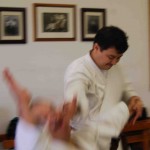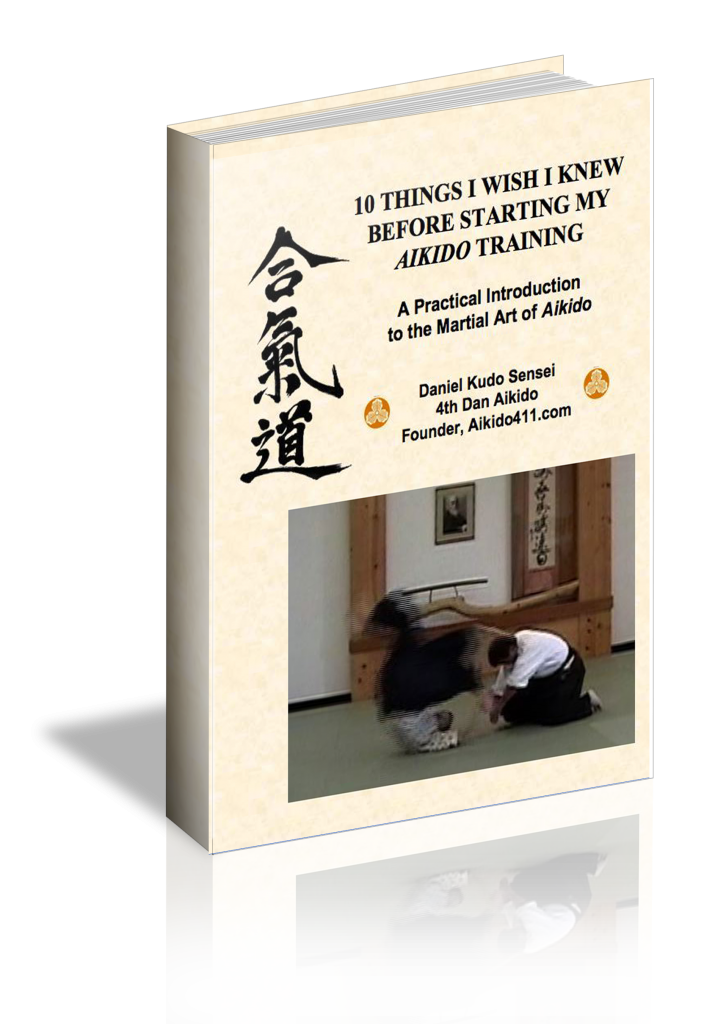Aikido Techniques: Blending is Harmony, Harmony is Love
The first syllable of Ai-Ki-Do is Ai, which can be interpreted in many ways. The Ai of Aikido Techiques in its most mechanical form is blending your energy with that of your partner (uke) which is to minimizes conflict of forces and, in fact, result in a summation or augmentation of energy. Ai can also be interpreted as love, as in aishite masu (loosly translated as “I love you”). In the broadest definition, we are demonstrating love and respect for our partner through the blending of energy rather than force on force conflict. So it is that blending makes us one with our partner. As applied to Aikido techniques, our forces unify which permits us to gain access to uke’s center permitting control through redirection of force.
O-Sensei demonstrate the concept of blending or harmonization. As uke’s attack there is essentially no resistance as movement joins the centers and balance is taken.
Aikido Techniques: Ude furi undo joins our centers
Watch a demonstration of ude furi undo, roughly defined as arm waving exercise, and what we “see” is arms moving around the center. Close inspection, however, reveals that movement (as will all movements in Aikido techniques) begins with the center and the arms following the lead of the one-point. Now, we add in uke that attacks with katate kosa dori (cross hand grab). The center moves causing the hands to “lead” uke as the attack focuses on the moving wrist. The movement is continued with the feet moving under the center in the ude furi choyaku undo manner, joining the centers as uke is now move outside the “turntable” whose center is your center. The defensive technique, kokynage (or timing throw), is executed as nage gains control of the uke’s head which, in turn, controls his center.
Aikido Techniques: Harmony Applied Off the Mat
In social interaction, the concept of Harmony has parallel applications. A disagreement is similar in concept to a direct attack focused on you. The normal response is to argue, which is another example of a “force on force” response. Using the ude furi choyaku analogy, one can CHOOSE to respond by first controlling the normal emotional response to a verbal “attack”. As my one of my key mentors, Bob Koga Sensei of the Koga Institute, would say “If you are not in control of yourself, it is impossible to control others”. The blending or harmonization is achieved by actively listening to this person’s point of view. The “unbalancing moment” comes from your restating their point of view. Why??? Most of us expect a hostile response to a negative comment. Actually restating their point of view, possibly better than originally stated is both unexpected and often unsettling, and does one more thing that helps to improve the relationship. Restating the other individual’s point of view actually satisfies the fundamental need to be heard and understood. This is, according to world-famous author, Steven Covey, the 5th element of the Seven Habits of Highly Successful People.
The net effect of this action is to completely defuse the hostile energy of the encounter and open the door to a respectful exchange of ideas. In this way, the individual that began as an “opponent” can now explorer how the two of you might have more similar points of view that would have originally anticipated. This is how, in human relationships, blending is harmony and harmony is love.


Leave a Reply